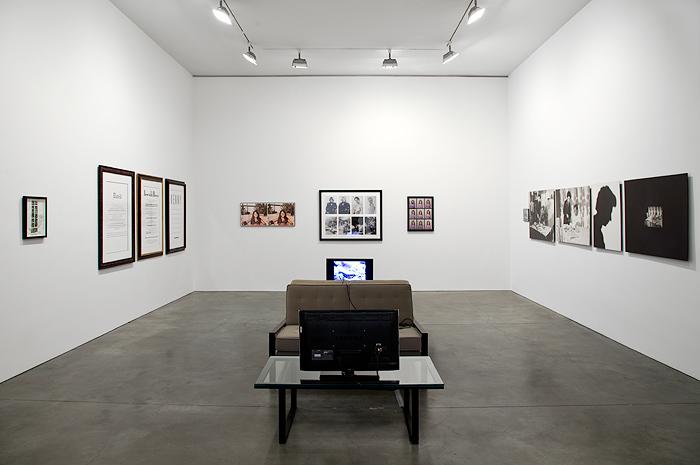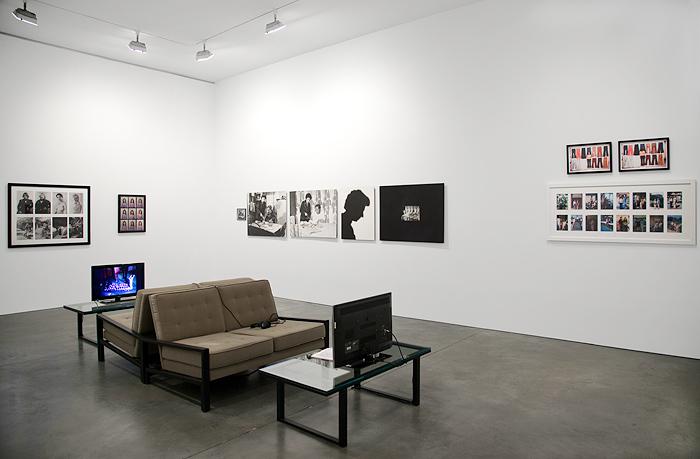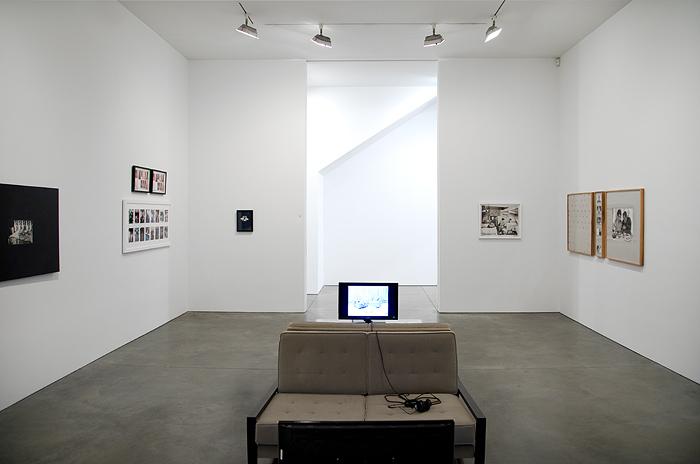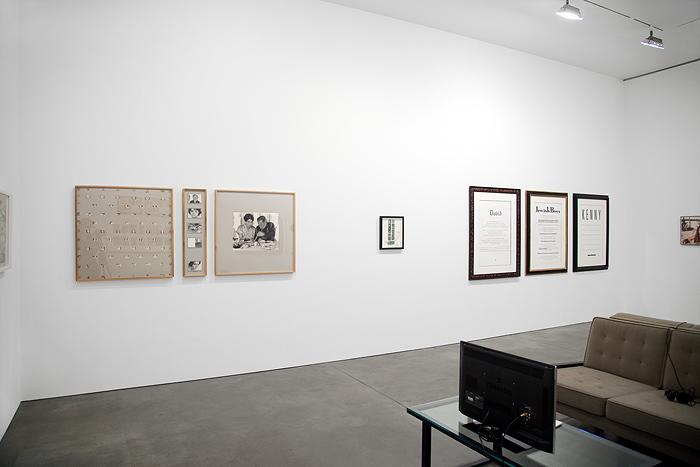Ilene Segalove
Curated by Dean Valentine
October 23 – December 4, 2010
Gallery 2
THE DISSATISFACTIONS OF ILENE SEGALOVE
Curated by Dean Valentine
In the generational army of the Baby Boom, Ilene Segalove and I belonged to a unit that fought just behind the front lines. We were born in the early 1950s. Our older comrades were at the forefront of the battles for Civil Rights, Women's Liberation and against the Vietnam War. Those just a bit younger came of age in the rubble of failed Utopian politics, and so were free (or forced, depending on your point of view) to pursue purely personal satisfactions, disguised as the ideology of self-realization. We, however, were the in-betweeners. The big marches passed us by, and when the Babas and RumDums and ests came on the scene, we were still in college, or just out. We were a bit of this, a bit of that, transitional and a bit in limbo. The emotional tenor of our moment was deflation, and its chief rhetorical mode was soft irony. Think Dustin Hoffman's famous dead stare in the last shot of "The Graduate."
Ilene Segalove's work belongs to that time. In a series of brilliant but accessible photographic works, videos and radio plays, she gave increasingly loud voice to the sense that something's not quite right, the plush and grand physical architecture that surrounds us (Segalove grew up in Beverly Hills) masks fragile and fragmented personal structures. In the "Mom Tapes," her mother wanders up and down Escher-like staircases, a ghost in a mansion, dispensing motherly advice on the best local butcher and where to buy housewares. There is a deep loneliness in these works, alleviated only by the obvious presence of her daughter with the camera—there both as daughter and in a more official anthropological capacity. In "How I Got Into TV," a Norman Rockwell scene around the family dinner table suddenly moves into the den, where her father stares hypnotized at the TV set, engrossed by the drama of JFK's funeral procession. At that point, Ilene realizes that if she wants her dad to pay as much attention to her, her best bet would be a career in television, a goal presumably achieved by the young girl pointing the Porta-Pak video camera and telling us her story. The great gap between Media and Life, between Illusion and Reality, between Things As They Should Be and Things As They Are—this gap forms the theme and substance of Ilene Segalove's work. There is no blue guitar, as Wallace Stevens never said.
But there is the blue light of the TV screen. Its cold light transforms everything and changes nothing. In our parent's generation, there was a chasm between the glittering images that flickered on towering screen in ersatz palaces and the two-bedroom homes down in Depression Valley. People worshipped Cary Grant and Greta Garbo and John Wayne and Marilyn Monroe. But they didn't expect to become them or live in their world, any more than the Greeks expected to move in next to Zeus on Mt. Olympus. TV—the TV my generation grew up with, "Leave It to Beaver," and "The Brady Bunch"—was different. Its illusions were of a more everyday, domestic kind. It sat in the living room of the home, and its screen was just another doorway into another room, where a family much like yours, but with no intractable problems and more perfect in every way, gathered in quotidian bliss. In our secret hearts, we expected to live in that world and wave to Jan as she bicycled past the window.
Well, it was all just an American dream and could never be anything but. There was no small amount of crybaby narcissism mixed in with the disappointment of waking up in the ruins. But there were also opportunities. One of those opportunities was to look at the architecture of one's own identity. "Who are you?" asked the Who. Sure, part of you is unique to you alone, but many other parts come pre-built, whether you like it or not. Segalove explores her female identity in a number of wryly funny, charming works, like "Nine Purple Packages," (1974) and "Close But No Cigar…," (1975). Indeed, if we look at her as a feminist artist—a term she would loathe, I'm sure—she stands exactly halfway between Martha Rosler and Cindy Sherman, without the hard-core politics of the one or the hard-core ironies of the other.
But the strengths of her work do not rest on political or social analyses. Although her mature creative life began in the bureaucratic and deadpan Conceptualism of the early 70s—she was part of the Cal Arts scene, and has always owed a debt to Baldessari—she quickly moved to a more accessible and autobiographical production. It was an ontological shift in the culture. If the Self no longer had political or social moorings, if its destiny was to be buffeted about in a shiny sea of media, then the Self would have to find its own authentic ground of Being. It would have to tell its own story. Every person, to paraphrase Joseph Campbell, would become his own religion. It is in this context that Ilene Segalove picked up the Porta-Pak, made her photo works and recorded her audio. Her mom, her dad, her sister, their home, her memories. Her eye and her voice recording their stories, her story, history. It's stuff anyone can relate to and everyone can understand. It shares impulses with Pop Art. It's easy to "get." I wish more art were like this.
The TV era is over. Television as a cultural force is spent, and what little vigor it has isn't directed to pitching us on a better world, but convincing us that those in the "know" never take anything seriously, least of all ideas and Ideals. No irony here, just us hipsters. On the one hand, contemporary art looks a lot like the forecourt of the temple, where the moneychangers hang. On the other, it is an insular and self-perpetuating church run by the Curatoria for its own ends. Ilene's work—and indeed, the work of the Conceptual artists—for decades have been promising a more democratic alternative. And perhaps the new technologies can finally deliver on those promises. Every kid who points a video camera at himself and tells his story to the world on You Tube owes Ilene and her fellow artists a great debt of gratitude. Whether it will satisfy her is a different matter.
Dean Valentine
Oct. 14, 2010
Ilene Segalove (b. 1950, Los Angeles) received her M.A. from Loyola University in 1975, and was also an active artist at Cal Arts. She began working in video in 1972, and also exhibited photography, collage, and later produced audio programs for National Public Radio. Her work has been consistently included in major group exhibition at the Museum of Modern Art, New York; Los Angeles County Museum of Art, and the Whitney through out her career. The Laguna Arts Museum organized a traveling solo exhibition in 1990, and more recently she has had two solo exhibitions with Tom Jancar Gallery, Los Angeles (2009 and 2010). Her work can be found in the public collections of the Getty Museum of Art, LA; the Hammer Museum, LA; the Los Angeles County Museum of Art, LA; Museum of Fine Arts, Houston, and the Jewish Museum, NY, among others. Ilene lives and works in Santa Barbara, California.
For press information please contact Jessica Eckert, j.eckert@rosengallery.com or Renee Reyes, r.reyes@rosengallery.com



